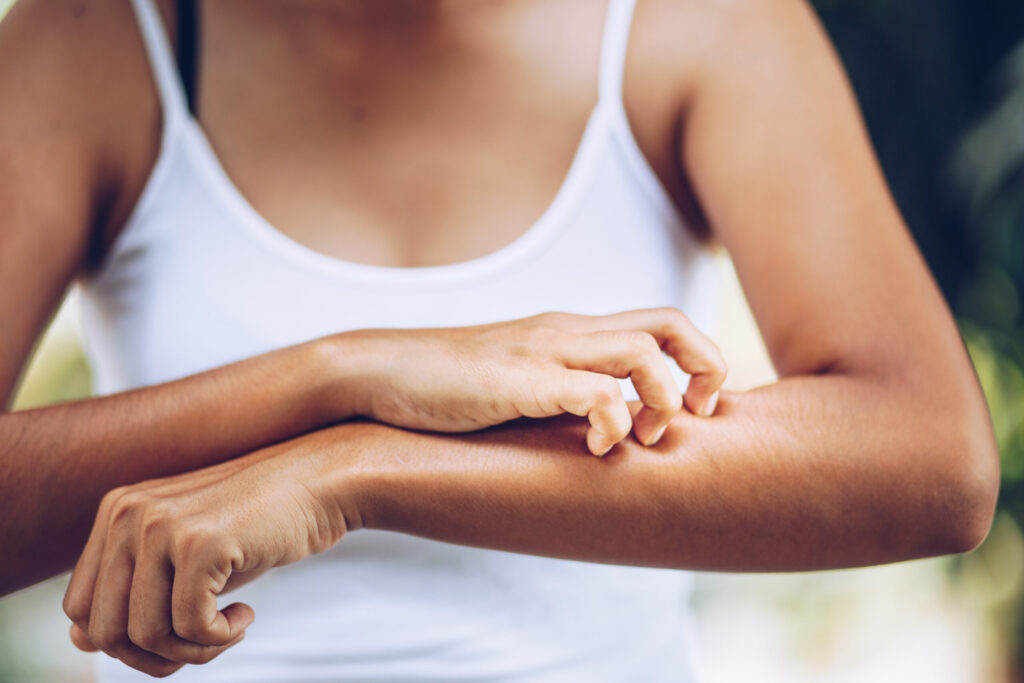
For best results in treating irritant contact dermatitis, avoid all substances which exacerbate symptoms and consult your GP or dermatologist regarding patch testing to identify allergens.
Hydrate regularly using non-scented lotion or ointment. Take an anti-itch drug like hydrocortisone cream or diphenhydramine (Benadryl). Trim fingernails regularly in order to avoid injuring skin further.
Contact Dermatitis
Contact Dermatitis can occur from irritation and allergens, appearing as red to purple patches of bumpy, itchy skin with blisters that can form anywhere on the body. It typically lasts from several days to two weeks but will typically go away if identified irritants/allergens are eliminated from exposure - for instance acetone, alcohol, metalworking fluids leather rubber latex detergent perfume and medicine such as Neomycin Sulfa Medicines Penicillin etc may all trigger dermatitis symptoms.
If you're confused as to what caused your rash, your provider may use a patch test. In this test, small patches containing possible allergens will be placed onto your skin for 48 hours before being removed; then any reactions are observed on subsequent patches placed. Your provider may recommend moisturizers or lotions with anti-itch ingredients as well as corticosteroid creams in order to reduce swelling and itching; in extreme cases they may prescribe oral corticosteroids pills as a course of treatment.
Rosacea
Rosecea, or Rosacea vulgaris, is a chronic skin condition characterized by facial redness and small blood vessels appearing on cheeks or nose. People with fairer skin might show more obvious symptoms. Red solid bumps that resemble acne and contain pus can form. Eye symptoms also frequently manifest themselves; soreness, watery eyes or styes may occur as part of its symptoms.
Rhinophimal (a skin thickening condition known as rhinophyma) may develop, giving the nose an irregular and bulbous shape. Furthermore, many individuals suffering from rosacea can also suffer from rhinoconjunctivitis: swelling or pulpy growths along their nasal passageways that causes nose conjunctivitis symptoms.
To manage the symptoms of rosacea, use gentle cleansers and oil-free cosmetics. Avoid foods or chemicals that irritate your face and keep a rosacea diary to see what triggers symptoms. Your doctor can prescribe topical medication such as Azelaic Acid Gel (Finacea) or topical vasoconstrictors like Oxymetazoline Rhofade that reduce pink bumps; oral antibiotics; anti-inflammatory drugs or even an antibiotic called Ivermectin Soolantra may also help treat symptoms. Laser and light therapy treatments may also be beneficial.
Melasma
Melasma is a non-painful skin condition characterized by dark patches on your body that appear as flat-looking dark patches. While not painful or harmful to health, its presence can be disconcerting and upsetting; typically uneven in terms of hue; these patches appear on cheeks, forehead, nose bridge, neck or arms as a discoloration.
Doctors don't fully understand what causes melasma, but it appears to be caused by various factors that alter melanin production. Hormones - specifically estrogen and progesterone levels during pregnancy - play an integral part in this condition's appearance, leading to its flareup during gestation. Sun exposure may aggravate it further so sunblock should always be worn when outdoors; doctors also suggest exfoliating with facial scrubs containing alpha-hydroxy acids such as glycolic acid to exfoliate and fade melasma spots while consulting a dermatologist can prescribe hydroquinone lotions, creams or gels in order to lighten patches of this condition's color.
Cysts
Cysts are collections of fluid or semi-solid material found within tissues that form cysts. Cysts can form anywhere in the body; most cysts contain air but some also may contain sweat, normal gland secretions (e.g. sebum), or breakdown products from dead skin cells (keratin). Cysts may occur as an outcome of certain dermatitis conditions like dyshidrotic and nummular eczema.
Epidermoid cysts and sebaceous cysts are two types of cysts found beneath the skin that commonly arise: flesh-colored or yellow smooth-surfaced lumps with epidermal cells moving subdermally instead of being shed off as normal; multiply and form walls around themselves to form cysts; while sebaceous cysts begin in glands which produce oily substances called sebum and produce an oily substance known as sebum that then create cyst walls.
Cysts may be drained or removed with help from a medical provider after being numbed, typically after local anesthesia has been provided. When infected cysts become pink or red and tender they require medical intervention such as draining an abscess or cyst along with antibiotics from a physician in order to be removed effectively.

.jpg)